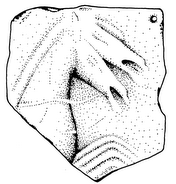Example of "walking":
Example of "looking":
Example of "stopping":

Example of "picking things up":

As you can see, the SEEP team is made up of an extraordinary band of professional athletes, all of whom can demonstrate these four very different techniques with expert precision. When executed properly and with repetition, the SEEP crew is often successful in identifying a variety of archaeological sites. At present we have identified several prehistoric sites, areas of Roman influence, and just recently we identified a site from the early bronze age which offered up a total of 290 pieces of obsidian (a volcanic glass used for creating blades and other sharp points) and many sherds of pottery (most of which were not collected).
But what exactly makes us professionals?
Well, saying that all we do is "walk, look, stop, and pick things up" is an incredibly simple interpretation of a relatively complex proceedure. To begin with, we can't walk just anywhere. The campos area that we survey is divided on our map into 100 x 100 meter squares. These squares are then divided into ten 100 meter long "transects." Each team member walks in the middle of a transect (it is believed that a person can see clearly 5 meters on each side). These 100 meter long transects are then further divided into 20 meter long sections. As we are walking through each section, we are taking careful notes of the visibility, geographical features, and the objects which we observe. Some of these objects (pottery sherds of higher quality, pieces of obsidian, and remains of man-made structures) are worth further examination. At this point the individual will stop and determine if the object is worth collecting. On occassion, a team member may identify many noteable objects in a specific area. It is then up to the Field Director to decide whether the area deserves a more detailed investigation. If the area yields a high number of objects (enough to signify the area as having a substantial human influence), it will be identified as a "Find Spot." Each of these Find Spots (such as the afore mentioned area in which we found 290 pieces of obsidian) is recorded using GPS and is given an identification number. Once the Field Director feels that we have thoroughly examined the site and collected all the relevant materials, then we continue on with our survey of that area. At the end of the day, each team member is responsible for entering all of their note sheets into the computer catalog and cleaning any objects found that day.
While SEEP doesn't have the pleasure of enjoying a typical Elementary School "Field Day," we instead enjoy a different sort of "day in the field." Our day is--hopefully--marked by numerous discoveries of varying significance. Whether we are pleasantly surprised by a sleeping turtle, shocked by a passing snake, or elated by a significant habitation site, we are always thrilled to be out in the field, quencing our insatiable thirst for discovery.



No comments:
Post a Comment